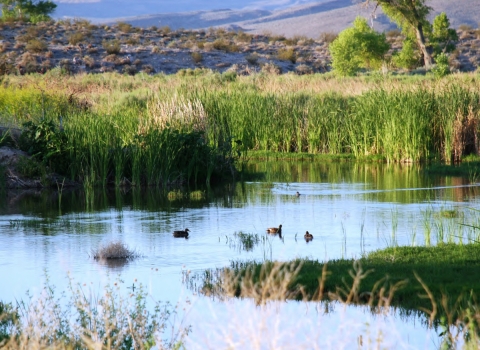U.S. Fish and Wildlife Service Director Dan Ashe underscored the importance of science at the agency and called attention to some of its top practitioners when he announced the recipients of the 2015 Rachel Carson and Sam D. Hamilton Awards for scientific excellence. The awards, made at a reception during the North American Wildlife and Natural Resources Conference in Pittsburgh, PA, honor Service employees and partners for their scientific contributions to improve the Service’s knowledge and management of fish and wildlife resources.
“Our nation’s fish and wildlife conservation system is founded upon the principle of sound science,” said Ashe. “This year’s award winners reflect the highest standard of scientific integrity and demonstrate exceptional leadership through their efforts to tackle two very complex conservation challenges.”
Gail Collins, Supervisory Wildlife Biologist at the Sheldon-Hart National Wildlife Refuge Complex, is the recipient of the Rachel Carson Award for Exemplary Scientific Accomplishment, which recognizes scientific excellence through the rigorous practice of science applied to a conservation problem to achieve conservation results for fish and wildlife.
At the Sheldon Refuge, Gail led multiple studies to document the ecological impacts to wildlife habitat from feral horses and burros. Her investigations provided strong scientific support to justify the controversial decision to remove the feral horse and burro population from Sheldon. The removal now complete, priority species such as pronghorn and greater sage-grouse are benefiting from improved habitat in the largest intact tracts of sagebrush sagebrush
The western United States’ sagebrush country encompasses over 175 million acres of public and private lands. The sagebrush landscape provides many benefits to our rural economies and communities, and it serves as crucial habitat for a diversity of wildlife, including the iconic greater sage-grouse and over 350 other species.
Learn more about sagebrush -dominated habitat in the West.
In 2015, the Service established the Sam D. Hamilton Award for Transformational Conservation Science in tribute to the fifteenth director of the Service. The award recognizes individuals and teams for the innovative application of science to large-scale conservation problems. By going beyond geographic and organizational boundaries, the partners of the Gulf Coast Vulnerability Assessment (GCVA) are deserving of this inaugural award.
Climate, sea level rise and urbanization are changing at extraordinary rates and are expected to have large effects on natural resources. The GCVA evaluated the potential impacts of these stressors on four Gulf Coast ecosystems and 11 associated species to assess their susceptibility to future change and aid in developing adaptation strategies.
The GCVA was initiated by the four Gulf coastal Landscape Conservation Cooperatives (LCCs) – Gulf Coast Prairie, Gulf Coastal Plains and Ozarks, South Atlantic, and Peninsular Florida LCCs – in partnership with the Gulf of Mexico Alliance and more than 50 partners from federal and state agencies, non-governmental organizations and academic institutions. The GCVA will guide conservation and restoration efforts by helping conservation partners across the Gulf identify vulnerable areas to focus critical resources.
The award recipients will receive $50,000 to be used at their field stations to support additional scientific work.
For more information about the Science Awards and the Service’s commitment to scientific excellence, visit: www.fws.gov/science/awards.html.



